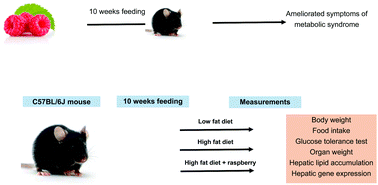Consumption of a single serving of red raspberries per day reduces metabolic syndrome parameters in high-fat fed mice
Abstract
Using an animal model for diet-induced metabolic disease, we have shown previously that the addition of raspberry juice concentrate (RJC) and raspberry puree concentrate (RPC) at a level of 10% of kcal, equivalent to four servings per day, to an obesogenic high-fat, western-style diet (HF) significantly reduced body weight gain, serum resistin levels, and altered the expression of hepatic genes related to lipid metabolism and oxidative stress. This study was designed to examine the effect of a lower level of RJC or RPC consumption, at a level representing a single serving of food per day (2.5% of kcal). For ten weeks, four groups of C57BL/6J mice (n = 8 ea.) were fed: low fat (LF), HF, HF + RJC, or HF + RPC diets. Intake of RJC and RPC decreased final body weight. Hepatic lipid accumulation was significantly decreased in HF + RPC- and HF + RJC-fed mice, compared to HF-fed mice. Further, the relative expression of hepatic genes including Heme oxygenase 1 (Hmox1) and Hormone sensitive lipase (Lipe), were altered by RPC or RJC consumption. In this mouse model of diet-induced metabolic disease, consumption of the equivalent of a single daily serving of either RPC or RJC improved metabolism in mice fed HF diet. We hypothesize that the phytochemicals contained in raspberries, and/or their subsequent metabolites, may be acting to influence gene expression and other regulatory pathways, to produce the metabolic improvements observed in this study.

- This article is part of the themed collection: Berry Health Benefits Symposium


 Please wait while we load your content...
Please wait while we load your content...